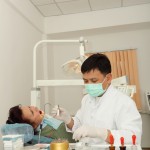
There is increasing interest in non-surgical approaches to the management of dental caries to preserve tooth structure. The aim of this study was to compare the effect of infiltrating vs. sealing proximal caries lesions against placebo after 3 years.
The study was a split mouth design conducted in young adults in Colombia. Individuals with 3 proximal lesions identified radiographically around the enamel-dentin junction to the outer third of the dentin, were included. Treatments were randomly allocated A (Infiltration: ICON-pre-product; DMG), test-B (Sealing: Prime-Bond-NT; Dentsply), or control-C (Placebo). Annual standardised bitewing radiographs were taken.
The primary outcome, radiographically observed lesion progression was assessed by an independent examiner blinded to groups, using pair-wise and digital-subtraction readings.
They found that in the 37 participants after 3 yrs,
- 10 lesions (A-4; B-2;C-4) progressed deep into dentin and needed operative treatment.
- The 3-year therapeutic effect, between
- infiltration and placebo was 37.8% (95%CI: 20.5-55.2%) and
- sealing and placebo was 29.7% (95%CI: 20.2-35.0%)
- There were no adverse events.
The authors concluded
infiltration and sealing are significantly better than placebo treatment for controlling caries progression on proximal lesions. No significant difference was seen between infiltration and sealing (ClinicalTrials.gov number CT01417832).
Martignon S, Ekstrand KR, Gomez J, Lara JS, Cortes A. Infiltrating/Sealing Proximal Caries Lesions: A 3-Year Randomized Clinical Trial. J Dent Res. 2012 Jan 17. [Epub ahead of print] PubMed PMID: 22257664.
Comment
The findings showed that while 70% of the lesions progressed in the placebo (group C), only 32% did so in group A and 40% in group B. As the authors point out, because of progression rates in each of the groups selection on appropriate cases and regular monitoring is important for the management of early lesions using non-operative interceptive treatment. The alternative surgical approaches, class-II cavity plus restoration results in loss of tooth structure and is by no means 100% successful.

Interesting study. What I’d really be interested in here is what you can do with preventive techniques which include behavioural modification support rather than simply placebo or even standard toothbrushing & flossing instruction – especially the long term (10 yrs plus) cost effectiveness of each and patient preferences.